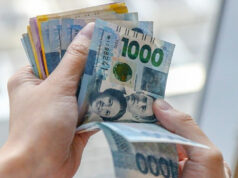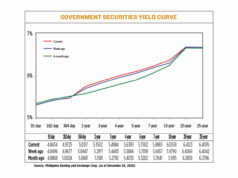BSP securities fetch lower rates

YIELDS on the Bangko Sentral ng Pilipinas’ (BSP) short-term securities declined further on Friday even as the offer went undersubscribed.
The BSP bills fetched bids amounting to P119.984 billion on Friday, below the P120-billion offer but higher than the P114.299 billion in tenders for the P110-billion auctioned off on June 20. This came as the one-month tenor was undersubscribed, leading to a partial award.
Broken down, tenders for the 28-day BSP bills reached only P58.887 billion, lower than the P60 billion placed on the auction block but higher than the P46.322 billion in bids seen for a 50-billion offer seen the prior week. The BSP accepted all the submitted bids.
Banks asked for rates ranging from 5.35% to 5.6%, a narrower margin compared to the 5.28% to 5.9% band seen a week earlier. This caused the average rate of the one-month securities to inch down by 1.6 basis points (bps) to 5.4745% from 5.4905% previously.
Meanwhile, bids for the 56-day bills amounted to P61.097 billion on Friday, higher than the P60-billion offering but lower than the P67.977 billion in tenders for the same offer volume in the prior week. The central bank made a full P60-billion award of the two-month securities.
Accepted rates were from 5.37% to 5.565%, a tighter range compared to the 5.29% to 5.58% margin seen the week prior. With this, the average rate of the 56-day securities went down by 2.02 bps to 5.5012% from the 5.5214% logged in the previous auction.
The central bank uses the BSP securities and its term deposit facility to mop up excess liquidity in the financial system and to better guide short-term market rates towards its policy rate.
The BSP bills also contribute to improved price discovery for debt instruments while supporting monetary policy transmission, the central bank said.
Data from the central bank showed that around 50% of its market operations are done through its short-term securities.
The BSP bills are considered high-quality liquid assets for the computation of banks’ liquidity coverage ratio, net stable funding ratio, and minimum liquidity ratio.
They can also be traded on the secondary market. — A.M.C. Sy



